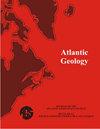Late- and Post-glacial history of the East Branch of the Penobscot River, Maine, USA
IF 0.9
4区 地球科学
Q2 GEOLOGY
引用次数: 4
Abstract
Between ~20 and 15 ka the Laurentide Ice Sheet retreated from the edge of the continental shelf, ἀrst to the Maine coast and then across Maine to the northern reaches of the Penobscot Lowland. The Lowland, being isostatically depressed, was inundated by the sea. As ice then retreated into Maine’s western mountains, valleys through the mountains became estuaries. In the estuary now occupied by the Penobscot River’s East Branch, ten ice-marginal deltas were built during pauses in this part of the retreat. By 14 ka the ice had retreated far enough to expose land in the valley bottom between the ice front and the sea, and the Penobscot River was (re)born. This occurred near the present conᴀuence of the Seboeis River and the East Branch. The river gradually extended itself northward as the ice retreated and southward as relative sea level fell. Braidplains were formed and incised, leaving terraces. High initial discharges eroded the eastern ᴀanks of the esker and deltas, redepositing silt, sand, and gravel all the way to the present head of Penobscot Bay. By ~10 ka the discharge had decreased, the river was adjusting to on-going differential isostatic rebound, and finer sediment was accumulating, forming the present floodplain.美国缅因州佩诺布斯科特河东支流的冰期晚期和后冰期历史
在约20至15 ka之间,劳伦泰德冰盖从大陆架边缘撤退,首先到达缅因州海岸,然后穿过缅因州到达佩诺布斯科特低地的北部。低地受到均衡力的影响,被海水淹没了。当冰撤退到缅因州的西部山脉时,穿过山脉的山谷变成了河口。在现在被佩诺布斯科特河东支所占据的河口,在这部分后退的间歇期,形成了十个冰缘三角洲。到公元14世纪,冰已经退缩得足够远,露出了冰锋和海洋之间山谷底部的陆地,佩诺布斯科特河(重新)诞生了。这发生在现在的西布瓦河和东支流交汇处附近。随着冰的消退,河流逐渐向北延伸,随着相对海平面的下降,河流逐渐向南延伸。辫状平原形成并切割,留下梯田。最初的高流量侵蚀了埃斯克和三角洲的东部堤岸,重新沉积了泥沙、沙子和砾石,一直沉积到现在的佩诺布斯科特湾的源头。约10 ka时,径流量减少,河流调整为持续的差均衡反弹,细粒泥沙积聚,形成了现在的洪泛平原。
本文章由计算机程序翻译,如有差异,请以英文原文为准。
求助全文
约1分钟内获得全文
求助全文
来源期刊

Atlantic Geology
GEOLOGY-
CiteScore
2.10
自引率
18.80%
发文量
0
审稿时长
>12 weeks
期刊介绍:
Atlantic Geology (originally Maritime Sediments, subsequently Maritime Sediments and Atlantic Geology) covers all aspects of the geology of the North Atlantic region. It publishes papers, notes, and discussions on original research and review papers, where appropriate to the regional geology.
 求助内容:
求助内容: 应助结果提醒方式:
应助结果提醒方式:


